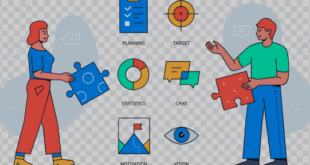Web development is a term that is often thrown around in today’s digital world, but for many people, it remains a bit of a mystery. If you’re someone who doesn’t have a technical background but is curious about what web development involves, you’re in the right place! This blog will provide a simple, straightforward introduction to web development, breaking it down into digestible chunks so that even non-techies can understand. By the end of this post, you’ll have a basic understanding of what web development is, why it matters, and how you can start learning if you’re interested.
What Is Web Development?
Web development refers to the process of building and maintaining websites. It involves everything from creating simple static web pages to developing complex dynamic websites or web applications. Web developers use various programming languages, frameworks, and tools to bring websites to life, ensuring they are functional, visually appealing, and user-friendly.
Why Does Web Development Matter?
In today’s world, nearly every business, organization, or individual has an online presence. Whether it’s an e-commerce website, a personal blog, or a corporate platform, web development makes these digital spaces possible. It allows users to interact with content, purchase products, or share information globally. Web development is a crucial part of shaping the online experience that billions of people use daily.
Types of Web Development
Web development can be broken down into three primary categories: front-end development, back-end development, and full-stack development. Let’s take a closer look at each.
Front-End Development
Front-end development is all about what users see and interact with on the web. It includes the design, layout, and overall structure of a website. When you visit a website, the elements you see—buttons, images, text, and even animations—are the result of front-end development. Front-end developers typically use languages like:
- HTML (HyperText Markup Language) – Used for creating the structure of a web page.
- CSS (Cascading Style Sheets) – Used to style the appearance of the web page, like colors, fonts, and layouts.
- JavaScript – Adds interactivity to the web page, allowing elements like buttons, forms, and animations to function.
If you’ve ever customized your social media profile or experimented with website themes, you’ve dabbled in front-end development!
Daily & Monthly Rent a Car Lahore Packages Available
Back-End Development
Back-end development refers to the server-side of the website, where all the behind-the-scenes processes take place. It involves managing databases, user authentication, and business logic. When you interact with a website, the front-end sends requests to the back-end, which processes these requests and sends back the necessary data. Some common back-end technologies include:
- Databases: MySQL, PostgreSQL, and MongoDB help store and manage data on a website.
- Programming Languages: Python, Ruby, PHP, and Node.js are used for writing the logic that powers websites.
- Servers: Apache and Nginx are popular web servers that serve the content to the users’ browsers.
In simple terms, the back-end is like the engine of a car—it’s not visible, but it makes everything run smoothly.
Full-Stack Development
Full-stack development combines both front-end and back-end development. Full-stack developers have the skills to build both the parts of a website that users interact with and the back-end systems that power those interactions. It’s a versatile skill set, allowing developers to create entire websites or web applications from start to finish.
If you’re just starting out and want to become a well-rounded web developer, learning full-stack development might be a good approach.
Key Skills for Web Developers
Now that we’ve explored the different areas of web development, let’s take a look at some key skills that web developers need to possess, regardless of which area they specialize in.
1. Problem-Solving
At its core, web development is about solving problems. Whether it’s figuring out how to display data on a page or making sure a website works on mobile devices, developers must think critically and find solutions to a variety of challenges.
2. Attention to Detail
Web development involves a lot of small details, such as ensuring that links work properly, text is formatted correctly, and images load smoothly. A good developer must pay close attention to these finer points to ensure that the user experience is as seamless as possible.
3. Creativity
While web development is technical, it also requires a creative mindset. Front-end developers, in particular, must be able to design visually appealing layouts and user interfaces that engage and delight users.
4. Communication
Web development often involves working with other people, whether it’s a designer, a project manager, or a client. Strong communication skills are necessary to ensure that everyone is on the same page and the project runs smoothly.
5. Continuous Learning
Technology is always evolving, and web development is no exception. Web developers must stay up-to-date with new technologies, frameworks, and best practices to remain competitive in the field.
How to Get Started with Web Development
If you’re a non-techie interested in learning web development, you’re in luck! There are many resources available to help you get started. Here are some steps you can take:
1. Start with the Basics: HTML, CSS, and JavaScript
The foundation of web development lies in three essential technologies: HTML, CSS, and JavaScript. Start by learning these languages, as they are the building blocks of web pages.
- HTML: Learn how to create the structure of a webpage using tags and elements.
- CSS: Understand how to style web pages with colors, fonts, and layouts.
- JavaScript: Learn how to add interactivity and dynamic content to your websites.
There are plenty of online tutorials and courses available for free on platforms like FreeCodeCamp, Codecademy, and MDN Web Docs to help you get started with these technologies.
2. Try Website Builders
If you’re looking for a quicker way to create a website without delving deep into coding, website builders like Wix, Squarespace, or WordPress can be a great option. These platforms provide pre-designed templates and drag-and-drop functionality, making it easy for anyone, regardless of technical ability, to create a professional-looking website.
3. Practice by Building Small Projects
The best way to learn web development is by actually doing it. Once you have a grasp on the basics, start building small projects. For example, you could create a personal blog, a portfolio site, or a simple business website. The more you practice, the more you’ll understand how everything works together.
4. Join the Developer Community
The web development community is full of people who love to share their knowledge and help others. Websites like Stack Overflow, Reddit, and GitHub are excellent places to ask questions, share your projects, and learn from others in the field.
Common Web Development Myths
There are a few misconceptions about web development that might make it seem more daunting than it actually is. Let’s debunk some of the most common myths:
1. “Web Development is Only for Programmers”
While coding is an important part of web development, it’s not the only skill you need. Many aspects of web development, such as design, project management, and content creation, don’t require advanced coding knowledge. Even if you’re not a programmer, you can still play a valuable role in web development.
2. “You Need to Be a Math Expert”
Many people believe that web development requires advanced math skills. In reality, most web development tasks rely more on logic and problem-solving than complex mathematics.
3. “You Can Learn Web Development in a Week”
Web development is a broad field, and becoming proficient takes time and practice. While you can certainly learn the basics in a week, mastering web development takes dedication and consistent effort.
FAQs About Web Development for Non-Techies
1. Do I need a computer science degree to get started with web development?
No, you don’t need a degree. Many successful web developers are self-taught, and there are plenty of online resources to help you learn.
2. How long does it take to learn web development?
It depends on your goals and how much time you dedicate to learning. A few months of consistent practice can help you build a solid foundation.
3. What is the difference between front-end and back-end development?
Front-end development focuses on the design and layout of the website that users interact with, while back-end development focuses on the server-side processes that power the website.
4. Can I make money as a web developer without a formal degree?
Yes, many web developers find freelance work or full-time jobs without a degree, especially if they have strong skills and experience.
5. Are web development skills in demand?
Absolutely! With more businesses and individuals building their online presence, web developers are in high demand across industries.
Conclusion
Web development might seem intimidating at first, but with the right resources and determination, anyone can learn the basics and even build their own website. By understanding the core concepts like front-end and back-end development, and starting with HTML, CSS, and JavaScript, you can embark on a rewarding journey into the world of web development. Don’t let the technical jargon scare you off—take it one step at a time, and you’ll be well on your way to becoming a web developer!
 Our Gateway to Insightful Blogging Exploring Ideas, Sharing Knowledge, Inspiring Minds
Our Gateway to Insightful Blogging Exploring Ideas, Sharing Knowledge, Inspiring Minds



